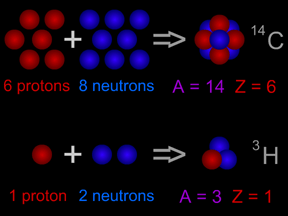Click on image for full size
Image courtesy of Plasma Physics Laboratory
Fusion Reactions
Nuclear fusion is a process where two or more nuclei combine to form an element with a higher atomic number (more protons in the nucleus). Fusion is the reverse process of nuclear fission. Fusion of light elements (the reactants) into heavier elements (the products) releases energy, (as does fission of heavy elements into lighter elements). For fusion, the energy release occurs when the mass of the fusion products is smaller than the reactants. The difference between the total masses of all the protons and neutrons of a nucleus and the mass of the nucleus itself can be expressed in terms of the binding energy. The energy released is proportional to the difference in the masses as predicted by Einstein's famous equation, E=mc2. Fusion reactions power the Sun and other stars.
For a fusion reaction to occur it is necessary to bring the reactants so close together that nuclear forces become important and "glue" the reactants together. However, the range of interaction of the nuclear force is very small (10-15 meters), and the reactants (positively charged nuclei) repel each other because of the electrostatic force. For these reasons fusion most easily occurs in a high density, high temperature environment.
On Earth, nuclear fusion was reached first in the explosion of the Hydrogen bomb. In a non-desctructive manner, fusion has also been reached in different experimental devices aimed at studying the possibility of producing energy in a controlled fashion (similar to what is presently done in nuclear power plants using fission). The D-T reaction is presently the best candidate for implementing a controlled fusion power station in the near future.















